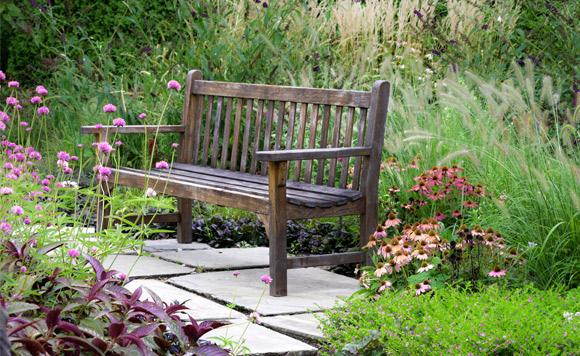by Katie Kroeker, Pacific Ridge Landscapes –
Are you looking for a little hideaway? Where silence can surround you, where you can breathe and reflect before life comes rushing in at you? Sounds like it might be time for a serenity garden.
Although, maybe “serenity garden” sounds too much like a cemetery for your taste. What about a meditation garden, zen garden, contemplative garden, prayer garden or even just quiet garden.
Regardless of the name we give it, we are following a millennia-old tradition of setting aside a sacred space in nature. Many people find just as much rest in simply being in a garden as others do in tending one. We don’t have to be gardeners to enjoy a garden. In fact, there can be great freedom in knowing that our garden exists without our constant attention and meddling.
Fortunately it doesn’t take much to make a quiet garden. The first step is determining if it will be a solitary garden or a shared garden, as this dictates the amount of space you need. Will it be a spot for contemplation or conversation? It could be the perfect spot for a screen-free morning coffee or it might be the place you and your loved one catch up at the end of the day. Decide if it is a place for sitting, reclining or even walking a labyrinth.
Everyone’s spacial needs are different, but as a general rule of thumb, keep the size small enough that you feel grounded in the space but large enough so that you don’t feel cramped. Creating a sense of enclosure is important, but it doesn’t necessarily mean installing a fence or privacy hedge, although in some cases, those might be appropriate. Choosing plants, shrubs or ornamental grasses in the three- to four-foot-tall range will help you feel nestled in, especially when seated, without blocking the broader view. It’s a personal preference as some people love being tucked in, away from the other parts of the garden, while others need a larger vista: a view of something bigger than themselves. If enclosing your quiet space isn’t an option, you could still define the boundary by creating some type of entrance or threshold to the space. A single piece of flagstone between two matching plants to signify the transition would work, or maybe you could step up or down into the space. As our bodies meet and cross these physical landmarks, it helps us to make the mental shift we need towards quiet and contemplation. Traditionally these gardens are weighted to green and white, but if colour makes you happy, pick one and repeat it.
Stay simple with your materials. A chair on the lawn or a little gravel area surrounded by pretty plantings can be all you need. If you can tuck the chair(s) under a tree canopy, even better. This is not the place for seasonal containers and accessories because it needs to feel different from the rest of your garden. It is the place for beautiful focal pieces: an antique garden bench or a vintage urn that is as lovely empty as it is when filled, a statue of buddha or even a simple birdbath for a guaranteed front row seat to nature’s playtime.
So go outside. Celebrate silence. Repeat.




